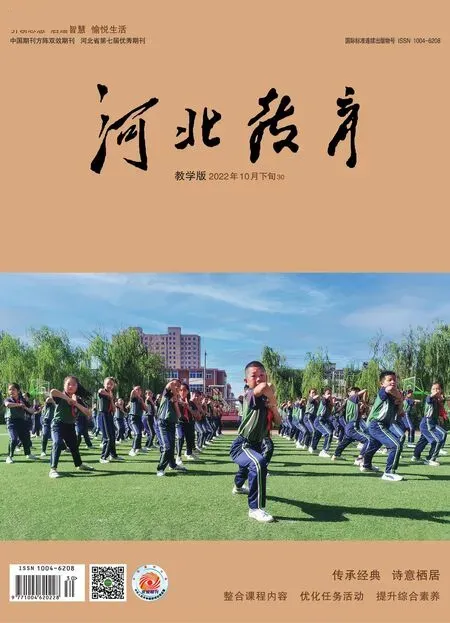小学英语故事教学的现状分析及改进对策
○崔向荣
冀教版小学英语教材中的Story time 作为单元教学中的重要板块,在延续单元话题的基础上,不仅能够复习巩固单元重点词汇和句型,帮助学生形成基本的阅读策略,提高学生的阅读兴趣和阅读能力,而且在培养学生思维品质和提升人文素养方面起着举足轻重的作用。但是在课堂教学中还存在着重故事内容的理解,轻故事情节的梳理;重阅读策略的提升,轻思维品质的培养;重语言知识的学习,轻人文素养的渗透等问题。本文以冀教版小学英语Story time 板块中的故事为例,分析当前故事教学中存在的典型问题,并探讨其解决方案,提高故事教学的实效性。
【教学回放】
教学内容:六年级上册Lesson 6Baby Becky at Home

T: Look,where is Baby Becky now?
SS: In the kitchen.
T: What does Baby Becky like to do?
S1: She likes to help her mother.
T: What do they do after lunch?
S1: Her mother washes the dishes.Baby Becky dries the dishes.
T: What does Baby Becky do in picture 2?
S2: She makes a house with the dishes.
T: What does her mother say?
S2:Baby Becky,don’t play with the dishes.
T: Let’s look at picture 3,what does Baby Becky do?
… …
【诊断分析】
本课讲述了小婴儿Baby Becky 在家中不同房间里发生的一系列有趣的故事。上述教学活动中,教师通过不断提出问题的方式逐图讲解故事内容,共提出了九个问题,问题过多且缺乏整体性和层次性。这些碎片化的问题侧重对故事内容的理解,却忽视了如何帮助学生厘清故事的脉络结构,搭建语言支架,导致学生在这个过程中慢慢失去了兴趣,最终整体输出语篇故事困难,语言表达缺乏条理性和逻辑性。
【教学重构】
教师引导学生带着问题“Where does Baby Becky go at home?”环游故事图片,整体感知故事内容,以地点的变化梳理故事情节的发展。
T: Look,this is Baby Becky’s house.What’s in Baby Becky’s house?
S1: There is a bathroom,a living room,a kitchen and two bedrooms.
T: Where does she go at home?Please look at the pictures on your book.
S2: She goes to the kitchen first,then she goes to the bathroom and living room,at last she goes to the kitchen again.
T: What does Baby Becky do in the kitchen?Please read P1-P4,try to find the answers.
教师和学生在解读故事文本的过程中,利用思维导图梳理整个故事的关键信息,以地点的变化厘清故事的发展脉络,建构故事的主要内容,为接下来的故事复述环节降低难度,培养学生的逻辑思维能力和概括能力。
【教学回放】
教学内容:六年级上册Lesson 12Be Safe on the Way

T: What will happen on the school bus?Let’s listen and judge.
T: Can you correct the sentences?Please read your books silently and underline the key words.
T: Ms.Marshall is a teacher.Yes or no?

SS:No.
T:Who can correct it?
S1:Ms.Marshall is a bus driver.
T:The children stand on the bus.Yes or no?
… …
T:You have done a good job.
【诊断分析】
Be Safe on the Way 这个故事属于“人与社会”范畴,涉及“上学路上的安全和公交车上的安全”,此话题与学生的生活联系紧密,容易引起学生的共鸣。本课教师在处理公交车上的安全这一故事情节时,采用了先听音判断,再默读文本的形式检查学生对词汇的理解。这种教学方式过分强调了对学生阅读策略的培养和故事内容的理解,却忽视了学生思维的发展,限制了学生的想象力,导致课上学生的参与度不高。教师应帮助学生在故事文本和学生知识与经验中搭建桥梁,挖掘故事文本背后的隐含信息,引发学生的积极思考和思维碰撞,提升思维品质。
【教学重构】
T: How to be safe on the bus?Let’s read P6-P8and try to find the answers.
S1: Please sit on the school bus.
S2: Please wear your seat belts.
T: What can you do on the school bus?What can not you do?Do you have any suggestions?
S3: Please sit on the school bus.Don’t play on the bus…
T: Look,who is she?
S4: She is Ms.Marshall.
T: Ms.Marshall is very nice.Would you like to be Ms.Marshall?
… …
T: The first day of school is always a happy and excited day.Always remember to be safe on the way.
学生通过默读找出“How to be safe on the school bus?”的答案,教师引导学生思考:What can you do on the school bus?What can not you do?Do you have any suggestions?激活学生已有的语言知识、生活经验和思维。通过问题“Where else do you wear seat belts?”发散学生思维,渗透安全意识。
【教学回放】
教学内容:六年级下册Lesson 12Helen Keller

T: When Helen Keller was 18 months old,she fell ill and became deaf and blind.What’s the meaning of deaf and blind?Let’s read picture 3 and find.
S1: Deaf means couldn’t see anything.
S2: Blind means couldn’t hear anything.
T:Deaf,letters“ea”pronounce /e/.Try to read: weather,bread,deaf.
Blind,letters“in”pronounce /ain/.Try to read: behind,kind,blind.
【诊断分析】
Helen Keller 是一篇人物传记类的文章。整个故事以时间为线索,讲述了海伦·凯勒在恩师安妮·莎莉文的帮助下克服自身困难,最后成为一名伟大作家的成长故事。上述教学活动中,教师先指导学生联系上下文理解词语的意思,再联系学过的单词,体会新单词的发音规律。这些教学活动仅仅停留在故事的表层信息,忽视了故事语境中人文素养的渗透,导致在后面的教学活动中对故事文本主题意义的探究不够深入。
【教学重构】
教师指导学生通过默读联系上下文理解了blind/deaf 的词义后,再引导学生尝试体会和感受海伦的世界。
T: How unlucky she was!Her world is always dark and silent.Let’s try to feel Helen’s world.Close your eyes and cover your ears.You can’t see anything.You can’t hear anything.It’s hard to do something.How do you feel if you were deaf and blind?
S1: I want to go to the toilet.But I can’t see anything.I feel scared.
S2: I like to play the piano.But I can’t hear anything.I want to cry…
本课故事的主题语境是人与自我,在学生学习语言知识和理解故事内容的基础上,教师引领学生感受海伦由于失聪失明所带来的困难,使学生产生情感共鸣,学习Helen Keller 身残志坚、刻苦学习的精神,达到学科育人的目的。当学生有了切身感受,表达的欲望自然强烈,学生才能在课上主动思考,表达观点,思维活跃。

